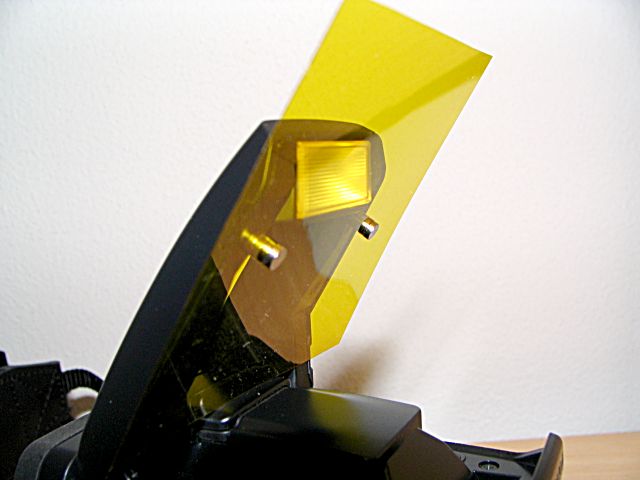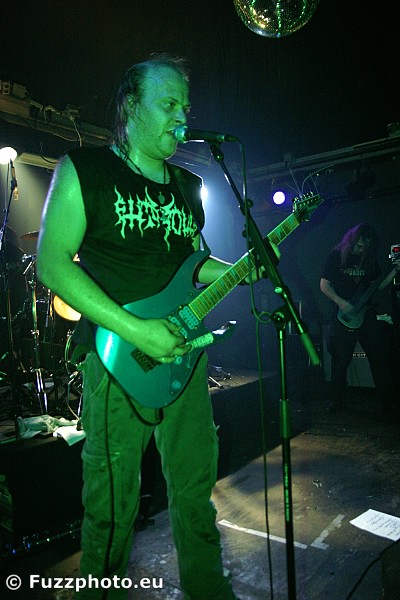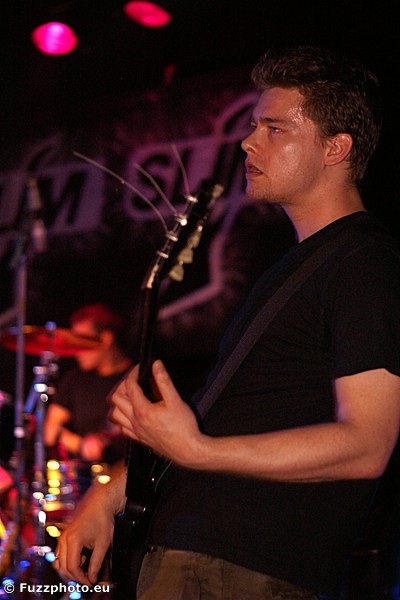Attach color gels to any flash
I found a very simple way to attach color gels to virtually any portable flash system. This way you can color balance a fill flash, make a simple bounce system or get downright wild effects. Or you can deliberately block visible light and only pass infrared to not spill any light into a scene when you're using wireless flash. I wrote a separate page about this: Infrared wireless flash.
Anyone can do this. As always, a picture says more than a thousand words, so I will simply show you:
Tiny magnets hold the gel filter in place:
A small stack is used as a stand-off so the gel won't buckle:
For illustration purposes I took a very large piece of filter gel. For normal use, these are just large enough to cover the flash bulb window.
For my particular cameras, the Sony Alpha 700 and the pictured Konica Minolta Dynax 5D, this was the easiest thing ever. Just below the flash tube are two tiny bolt heads. A stack of tiny Neodymium magnets attaches directly to them. For your camera flash or portable flash you may have to find the right spot where the magnets will attach or use a tiny bit of super glue to glue the magnets onto a position that will allow the flash head to move and close (if applicable).
I'm sure there are lots of handy systems available that do exactly the same thing. But for an amateur just having fun they're usually too expensive and I've never come across one for an on-camera flash either.
Portable flash guns and on-camera flashes are small, making it not very worth wile to buy rolls of gel filter. You could use cut up PAR spot sized ones, like you see above. The strong yellow is just something I had lying on the shelf at that time. But really the best tip I can give you is to get your mitts on a filter swatch book. Rosco and some others carry them (Rosco used to give them away for free, but I heard they don't do that anymore). You'll have a huge range to choose from in a small package and the swatches are large enough to fit most portable flash heads. You may have to cut out the swatches to be able to use them, but maybe some of these books allow you to remove and replace them. I modified the Rosco book by replacing the plastic pin by a bolt and nut with a spacer in between.
 The fact that I used Neodymium (see image on the right) magnets for this, is because they are extremely powerful. Even the minuscule sized ones. I couldn't get the gel to come off by blowing firmly onto it. Try this with normal magnets this size, if you can get them at all. Speaking of which, you'll probably want to know where I got the magnets in the first place. Follow this link to Engineering Concepts, run by George Mizzell, a very friendly gentleman, and there you'll find every magnet imaginable. You might want to get very thin ones if you have to glue them. And always remember: get them as small as possible in order to not disrupt camera operation. For this project I ordered 50 pcs. of the D1007 type. They are so tiny they cost next to nothing. While you're at it, look around and order some more, so the owner can make a buck. The larger ones require some care as they can actually be quite dangerous when body parts are caught in between them. Yes, they're that strong! I highly recommend the .75" cubes.
The fact that I used Neodymium (see image on the right) magnets for this, is because they are extremely powerful. Even the minuscule sized ones. I couldn't get the gel to come off by blowing firmly onto it. Try this with normal magnets this size, if you can get them at all. Speaking of which, you'll probably want to know where I got the magnets in the first place. Follow this link to Engineering Concepts, run by George Mizzell, a very friendly gentleman, and there you'll find every magnet imaginable. You might want to get very thin ones if you have to glue them. And always remember: get them as small as possible in order to not disrupt camera operation. For this project I ordered 50 pcs. of the D1007 type. They are so tiny they cost next to nothing. While you're at it, look around and order some more, so the owner can make a buck. The larger ones require some care as they can actually be quite dangerous when body parts are caught in between them. Yes, they're that strong! I highly recommend the .75" cubes.
But what's this all about, you ask. Why would you want to alter the color of your flash? Well, for instance if you use your flash as a slow sync flash (the best use for an on-camera flash if you ask me), you can now match the flash color temperature to the available light for a much more natural effect or for a more pronounced warmer or cooler effect. Things you can't do with a simple white balance adjustment. Imagine you're shooting in tungsten light. The fill flash would be a 5500 K bright white, while the room lighting is downright yellow at 3500 K. Balancing between those two is quite a daunting task, requiring a good feeling of what will work and what won't, and will probably end in many failed shots. Get a small piece of amber colored gel to bring down the flash color temperature to tungsten temperature and you'll see instant improvement. Another possibility is to use it as an effect, using completely over-the-top colors and again balance it with the available light. Yet another use is when you're at a concert with colorful stage lighting. Squash on a wild color and just let your fill light blend in with the rest of the stage light. Or put on a reflective piece of foil and use it as a simple flash bounce. Or use a diffusion sheet along with a color to even out things.
An example of a wild color to get more light onto a dark concert stage:

(Pictured is Graftak, guitarist and vocalist for Brandhaard)
Two example of a less wild color. These were fill flashed with a straw colored filter to get a very warm tone:

(Pictured is guitarist for New Par)

(Pictured is one of the guitarists for Persistense)
 Photography
Photography
Fuzzcraft.com comment system 1.1
No signing up, no censoring, no hassle, no strings attached, no nothing.
Please, English or Dutch only. If you don't really want your message to appear in public, consider contacting me privately.